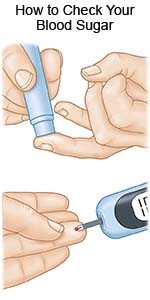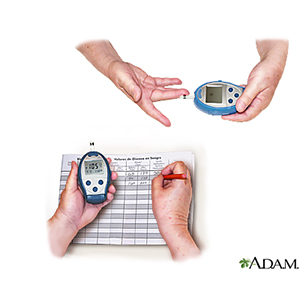WHAT YOU NEED TO KNOW: Why do I need to check my blood sugar level? High blood sugar levels increase your risk for heart attack, stroke, eye problems, and kidney problems. You can decrease your risk by controlling your blood sugar levels. Low blood sugar levels can also lead to serious health problems and must be treated right away. Check your blood sugar to help you learn how food, exercise, stress, and medicines affect your levels. Keep a record of your blood sugar levels. It can be used to adjust your meal plan, exercise routine, insulin doses, or diabetes medicine if needed. How do I check my blood sugar level? - Check your blood sugar level with a glucose meter. This device uses a small drop of blood to measure your blood sugar level. Some glucose meters measure a drop of blood taken from your finger using a special lancet device. Other meters will also measure a drop of blood taken from your thigh, forearm, or the palm of your hand.
- Blood sugar levels change quickly after meals, after you take insulin, during exercise, and when you feel stressed or ill. It is best to use blood from your finger to check your blood sugar level during these times. Your healthcare provider will teach you how to use a glucose meter to check your blood sugar level. Ask your healthcare provider for more information about taking blood samples from areas other than your finger.

|
What should I ask my healthcare provider about blood glucose meters? There many different types of meters and test strips. Healthcare providers will help you choose the best meter for you. Ask your healthcare provider the following questions when you are choosing a meter: - Is the meter the right size for me?
- Is it easy to see the numbers in the display area?
- Does the meter have a memory that keeps track of my blood sugar levels?
- Does the meter keep track of other details that I need?
When and how often should I check my blood sugar level? Ask your healthcare provider when and how often you should check your blood sugar levels. You may need to check your blood sugar 3 times a day or more. If you check your blood sugar level before a meal, it should be between 80 and 130 mg/dL. If you check your blood sugar level 1 to 2 hours after a meal, it should be less than 180 mg/dL. Ask your healthcare provider if these are good goals for you. Blood sugar levels need to be checked more often when you are sick, or if you change your daily routine. Test your blood sugar level if you feel like it may be too high (hyperglycemia) or too low (hypoglycemia). How do I keep a record of my blood sugar levels? Write down your blood sugar level each time you test it. Write down the date, the time of the test (including if it was before or after a meal), and the result. Write down the time you took your insulin or diabetes pills. Record the type and amount of insulin or diabetes medicine you took. Write comments about anything that may have made your blood sugar level go up or down. Your blood sugar level can be affected by exercise, eating more or less than usual, or stress. Bring this record with you to your follow-up visits. 
|
What should I do if my blood sugar level is too low? Your blood sugar level is too low if it goes below 70 mg/dL. Eat or drink a small amount of fast-acting carbohydrate, or take 4 glucose tablets (15 to 20 grams of glucose). Check the level again 15 minutes later. If it is above 70 mg/dL, eat a small snack. If it is still below 70 mg/dL, eat a small amount of fast-acting carbohydrate, or take 4 glucose tablets. Your healthcare provider or dietitian can tell you which fast-acting carbohydrates to eat, and how much is safe for you. Ask your healthcare provider for more information on hypoglycemia (low blood sugar level). How do I take care of my glucose meter and test strips? - Store your equipment properly. Keep the test strips away from heat, cold, and moisture. Do not take a test strip out of the container until you are ready to use it. Put the lid back tightly on the container. Do not use test strips that are damaged, wet, or bent.
- Check the expiration date on the test strip container to be sure the test strips have not expired. Your blood sugar readings may be wrong if you use expired test strips. Use only the type of glucose test strips that work with your glucose meter.
- Code your meter correctly so that the meter matches the code on each new bottle of test strips you use. If your meter is not coded correctly, your blood sugar readings may be wrong. Follow the instructions for entering the code that came with your meter or strips.
- Check the accuracy of your meter by testing a drop of control solution. Control solution often comes with a meter or can be bought at drug or medical supply stores. The blood sugar reading of the control solution should match the one that is listed on the bottle.
What are the risks of not testing my blood sugar level? Uncontrolled diabetes can damage your nerves, veins, and arteries. Long-term high blood sugar levels can damage your eyes and kidneys. Damage to arteries increases your risk of heart attack and stroke. Nerve damage may also lead to other heart, stomach, and nerve problems. Diabetes is life-threatening if it is not controlled. Call 911 for any of the following: - You have chest pain.
- You have a seizure.
When should I seek immediate care? - You have a fast heartbeat.
- You are weak, sweaty, or pale.
- You are breathing faster or slower than normal, are very sleepy, or your breath smells fruity.
- You feel dizzy, lightheaded, shaky, or confused.
- You are vomiting.
- You have a headache.
- You feel like you are going to faint.
When should I contact my healthcare provider? - You have trouble controlling your blood sugar.
- You have a fever.
- Your vision is blurry.
- You are more hungry or thirsty than usual.
- You urinate more than usual.
- You have questions or concerns about your condition or care.
|